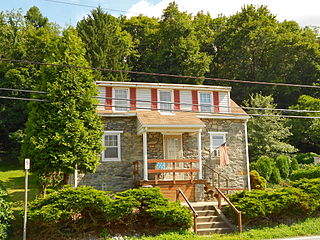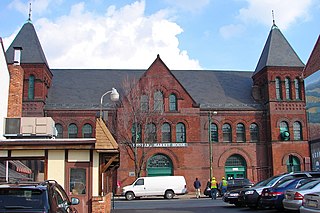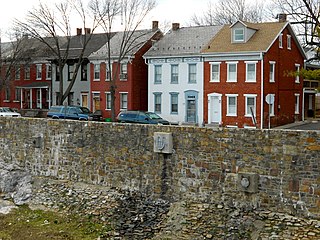
College Hill is a neighborhood in the west central section of the United States city of Greensboro, North Carolina. College Hill was Greensboro's first neighborhood.

The Washington Park Historic District is a national historic district located in Indianapolis, Indiana. It was listed on the National Register of Historic Places on June 24, 2008. It comprises nearly 60 acres (240,000 m2) and is located 4 miles (6.4 km) north of downtown Indianapolis, in the south-central part of the Meridian-Kessler neighborhood. The district includes all properties south of 43rd Street and north of 40th Street, and west of Central Avenue and east of the alley running north and south between Pennsylvania and Meridian Streets; Washington Boulevard runs north-south through the center of the district. It includes 110 contributing buildings, ranging mostly from mansions to small bungalows, and three non-contributing buildings.

Virginville is a census-designated place in Richmond Township, Berks County, Pennsylvania, United States. It is located at the junction of PA 143 and Crystal Ridge Road, and is approximately seven miles to the south of the borough of Lenhartsville.

Newington Junction is a section of the town of Newington, Connecticut, United States. It is centered at the intersection of Willard Avenue and West Hill Road in the northwestern part of the town, in the area generally just south of the Hartford city line. The name of the area refers to the railroad junction where the railroad line from New Haven meets with the railroad line from Bristol and Waterbury. The development of Newington Junction as a result of the railroad was instrumental in the separation of the town of Newington from its mother town of Wethersfield.

Emory Grove is a small area of bungalow style homes built in 1939 and the 1940s in Druid Hills, Georgia near Emory University. The Emory Grove Historic District, located between Emory University and the city of Decatur, Georgia, is a 90-acre (36 ha) historic district that was listed on the National Register of Historic Places in 2000.

The Moxham Historic District is a national historic district that is located in Johnstown in Cambria County, Pennsylvania.

The Red Lion Borough Historic District is a national historic district that is located in Red Lion Borough in York County, Pennsylvania.

The Pleasureville Historic District is a national historic district that is located in Springettsbury Township in York County, Pennsylvania.

The York Historic District is a national historic district that is located in the central business district and surrounding residential areas of York in York County, Pennsylvania. It is situated north of the Springdale Historic District.

Fairmount Historic District is a national historic district located in the Fairmount neighborhood of York in York County, Pennsylvania. The district includes 101 contributing buildings and 1 contributing site in a residential area of York. The neighborhood was developed between 1889 and about 1915, and includes notable examples of the Queen Anne and Second Empire styles.
Northwest York Historic District is a national historic district located in the Northwest York neighborhood of York in York County, Pennsylvania. The district includes 815 contributing buildings, 1 contributing site, and 1 contributing structure in a residential area of York. The neighborhood was developed between 1882 and 1930, and includes notable vernacular examples of various Late Victorian styles, Colonial Revival, and American Foursquare.

Brownsville Northside Historic District is a national historic district located adjacent to the Brownsville Commercial Historic District at Brownsville, Pennsylvania. The district includes 188 contributing buildings and 2 contributing sites in a neighborhood of Brownsville. Most of the contributing buildings are residential, with some commercial buildings and nine churches. The house styles are reflective of a number of popular 19th- and early-20th-century architectural styles including Colonial Revival, Bungalow / American Craftsman, and Greek Revival. The oldest building is Brashear's Tavern, and there are five buildings that date between 1815 and 1840. The contributing sites are cemeteries associated with two of the churches, including Christ Church, the burial site of Brownsville namesake Thomas Brown. Located in the district and separately listed are the St. Peter's Church and Bowman's Castle.

The Oak Park Historic District is a national historic district that is located in Hatfield Township, Montgomery County, Pennsylvania.

The Oil City North Side Historic District, also known as Cottage Hill, Palace Hill, and Polish Hill, is a national historic district that is located in Oil City, Venango County, Pennsylvania.

The Honesdale Residential Historic District, is a national historic district which is located in Honesdale, Wayne County, Pennsylvania.

The Springdale Historic District is a national historic district that is located in New Hope, Bucks County, Pennsylvania.

Jefferson Historic District is a national historic district located at Lafayette, Tippecanoe County, Indiana. The district encompasses 161 contributing buildings, 2 contributing sites, and 22 contributing structures in a predominantly residential section of Lafayette. It developed between about 1853 and 1951 and includes representative examples of Italianate, Greek Revival, and Bungalow / American Craftsman style architecture. Notable contributing resources include the Deutsche Evangelische Kirche (1905), Isador Metzger House, Hubert Gilmartin House, B.F. Biggs Pump Factory Building, Deutsche Methodist Kirche (1885), Herman & Mary Fletemeyer House, Mohr House, Warrenberg-Reule Double House, Alfred Gaddis House, Wabash Valley House (1862), Haywood Tag Company Building (1928), and Jefferson High School (1927).

Ninth Street Hill Neighborhood Historic District is a national historic district located at Lafayette, Tippecanoe County, Indiana. The district encompasses 88 contributing buildings and 6 contributing structures in a predominantly residential section of Lafayette. It developed between about 1850 and 1946 and includes representative examples of Gothic Revival, Italianate, Queen Anne, Greek Revival, and Second Empire style architecture. Located in the district is the separately listed Judge Cyrus Ball House. Other notable contributing resources include the Samuel Moore House (1891), Moore-Porter-Boswell House (1895), Stanley Coulter House (1890), Edward Bohrer House (1909), Thomas Wood House, Job M. Nash House (1859), and Gordon Graham House.

Flanner House Homes is a national historic district located at Indianapolis, Indiana. The district encompasses 180 contributing buildings in the Project Area "A" of Indianapolis. It was developed between about 1950 and 1959, and includes single family and duplex dwellings for African-American families. Notable buildings include the Revival Temple Church.

The Camp Harlan-Camp McKean Historic District, also known as the Hugh B. and Mary H. Swan Farmstead and the Springdale Stock Farm, is a nationally recognized historic district located northwest of Mount Pleasant, Iowa, United States. It was listed on the National Register of Historic Places in 2013. At the time of its nomination it consisted of eight resources, which includes two contributing buildings, one contributing site, one contributing object and four non-contributing buildings.























